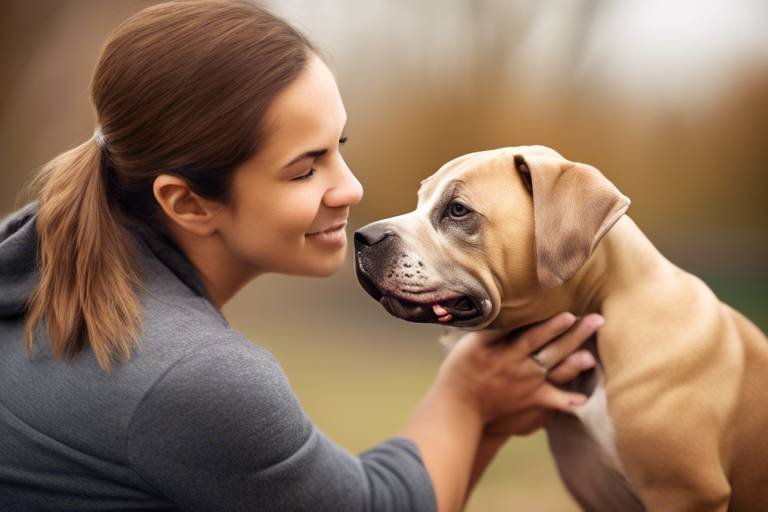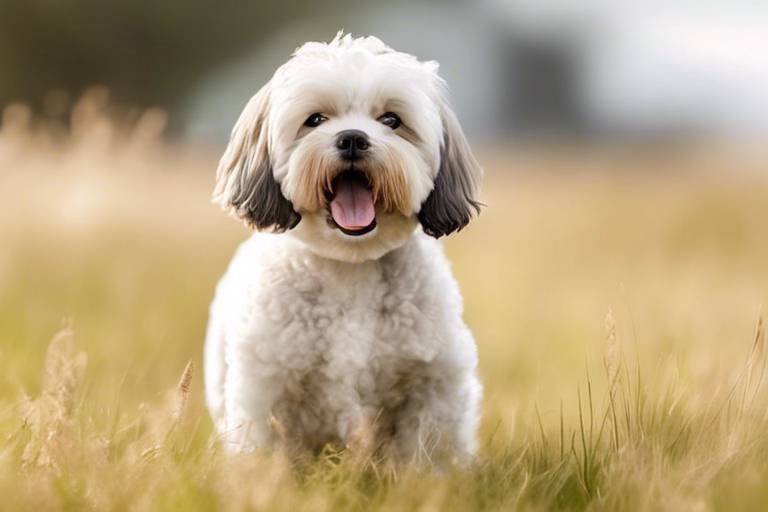How to Care for Your Purebred Dog - Breed-Specific Tips
Owning a purebred dog is a rewarding experience, but it comes with its own set of responsibilities. These beautiful creatures often have unique traits and needs that differ significantly from mixed breeds. Understanding how to care for your purebred dog means diving deep into their specific requirements, from nutrition to exercise and everything in between. By tailoring your care approach, you can ensure that your furry friend leads a happy and healthy life. So, let’s embark on this journey together and explore the essential tips that every purebred dog owner should know!
Different breeds possess distinct traits that influence their care. For example, a Greyhound has a sleek build and requires less exercise compared to a Border Collie, which is known for its high energy and intelligence. Understanding these characteristics helps owners tailor their approach to nutrition, exercise, and training, ensuring their dog’s needs are met. Each breed comes with its own set of quirks and preferences, much like how people have their own personalities. By recognizing these traits, you can create a nurturing environment that aligns with your dog's natural instincts.
When it comes to nutrition, each breed has specific dietary requirements based on size, age, and health. For instance, larger breeds like Great Danes may require a diet formulated for larger dogs to support their growth and prevent joint issues, while smaller breeds like Chihuahuas may need calorie-dense food due to their fast metabolisms. This section explores the best food options and feeding schedules to promote optimal health and prevent breed-related issues. A well-balanced diet can be the difference between a vibrant, energetic dog and one that struggles with health problems.
Certain purebred dogs are prone to specific deficiencies. For example, Boxers can be susceptible to heart issues, while Cocker Spaniels may face ear problems due to their long ears. Identifying these can help owners choose the right supplements and food to support their dog’s health and well-being. A simple trip to the vet can help you pinpoint any potential deficiencies, allowing you to adjust your dog’s diet accordingly. Always consult with your veterinarian before making significant changes to your dog’s diet.
Some breeds may benefit from additional vitamins or minerals. For instance, Golden Retrievers might need omega fatty acids to maintain a healthy coat, while Bulldogs could require joint supplements due to their unique body structure. This subsection discusses which supplements are most beneficial for various purebred dogs and how to incorporate them into their diet. Always look for high-quality supplements and ensure they are appropriate for your dog's specific breed and age.
Establishing a proper feeding routine is crucial. This section outlines general feeding guidelines tailored to different purebred breeds, ensuring they receive the right amount of nutrition. For example, a typical feeding schedule for a medium-sized dog might include two meals a day, while smaller breeds may benefit from three smaller meals. Regular feeding times not only help with digestion but also create a sense of security for your dog. Remember, always measure food portions to avoid overfeeding, which can lead to obesity and other health issues.
Proper hydration is vital for all dogs. This part highlights the importance of water intake and how it varies among different breeds. Larger breeds may require more water, especially after exercise, while smaller breeds might drink less but still need consistent access to fresh water. To encourage drinking, consider using a pet water fountain, which can make the experience more enticing for your dog. Keeping your dog hydrated is as critical as their diet, so always keep an eye on their water bowl!
Exercise needs differ significantly among purebred dogs. Some breeds, like Beagles, thrive on daily walks and playtime, while others, like Shih Tzus, may be content with a leisurely stroll around the block. This section details the appropriate types and amounts of exercise for various breeds to keep them physically and mentally stimulated. Regular exercise not only helps maintain a healthy weight but also prevents behavioral issues that arise from boredom and pent-up energy.
Understanding a breed's activity level helps owners plan suitable exercise routines. For example, high-energy breeds like Australian Shepherds require vigorous exercise and mental challenges, while low-energy breeds like Basset Hounds may prefer a more relaxed lifestyle. This subsection categorizes breeds based on their energy levels and suggests ideal activities for each group. Finding the right balance of exercise is crucial to ensure your dog remains happy and healthy.
Training and socialization are crucial for a well-adjusted dog. Early exposure to different environments, people, and other animals can help prevent behavioral issues down the line. This part discusses effective training methods, such as positive reinforcement, and the importance of socializing purebred dogs from an early age. Remember, a well-trained dog is not only a joy to have around but also a safer companion. Consider enrolling in obedience classes or puppy socialization groups to help your dog learn the ropes in a fun and supportive environment.
- What is the best diet for my purebred dog? It's essential to choose a diet that aligns with your dog's specific breed, age, and health needs. Consult your veterinarian for tailored recommendations.
- How much exercise does my purebred dog need? Exercise requirements vary by breed. Research your dog's breed to determine the appropriate amount and type of exercise.
- When should I start training my purebred dog? Start training and socialization as early as possible, ideally during puppyhood, to ensure your dog grows up to be well-adjusted and obedient.

Understanding Breed Characteristics
This article provides essential tips for caring for purebred dogs, focusing on their unique needs and characteristics. Learn how to ensure a happy, healthy life for your canine companion.
When it comes to caring for your purebred dog, understanding breed characteristics is key. Just like people, dogs have their own personalities, quirks, and needs that are influenced by their breed. For instance, a Border Collie will have different exercise and training requirements compared to a Bulldog. Knowing these differences allows you to tailor your approach to nutrition, exercise, and training, ensuring that your furry friend leads a happy and fulfilling life.
Every breed has its own set of traits that can influence not only how they behave but also how they interact with their environment and their human companions. For example, some breeds are known for their high energy levels and require a lot of physical activity, while others are more laid-back and enjoy lounging around. Understanding these characteristics can help you avoid common pitfalls that many dog owners face, such as over-exercising a breed that doesn't need it or under-stimulating a highly energetic breed.
Here are a few key breed characteristics to consider:
- Size: Larger breeds often require more space and different nutritional needs compared to smaller breeds.
- Temperament: Some breeds are naturally more aggressive or protective, while others are friendly and sociable.
- Grooming Needs: Breeds with long or thick coats may need regular grooming to prevent matting and skin issues.
- Health Concerns: Certain breeds are predisposed to specific health issues, which can affect their care and diet.
For example, breeds like the German Shepherd are known for their intelligence and loyalty but can also suffer from hip dysplasia. On the other hand, Chihuahuas may be small in size but have a big personality and can be prone to dental issues. By familiarizing yourself with your dog's breed, you can be proactive in managing these traits and health concerns.
Moreover, understanding breed characteristics can also enhance your dog's socialization. For instance, some breeds may be more reserved around strangers, while others might be overly enthusiastic. Knowing this can help you introduce your dog to new people and environments in a way that feels safe and comfortable for them, reducing stress and anxiety.
In summary, taking the time to understand your purebred dog's unique characteristics is not just beneficial—it's essential. It allows you to create a tailored care plan that meets their specific needs, ensuring they live a long, happy, and healthy life by your side. So, whether you’re a new dog owner or a seasoned pro, remember that each breed is a unique tapestry of traits that requires a thoughtful approach to care.
Each breed has specific dietary requirements based on size, age, and health. This section explores the best food options and feeding schedules to promote optimal health and prevent breed-related issues.
Certain purebred dogs are prone to specific deficiencies. Identifying these can help owners choose the right supplements and food to support their dog’s health and well-being.
Some breeds may benefit from additional vitamins or minerals. This subsection discusses which supplements are most beneficial for various purebred dogs and how to incorporate them into their diet.
Establishing a proper feeding routine is crucial. This section outlines general feeding guidelines tailored to different purebred breeds, ensuring they receive the right amount of nutrition.
Proper hydration is vital for all dogs. This part highlights the importance of water intake and how it varies among different breeds, along with tips to encourage drinking.
Exercise needs differ significantly among purebred dogs. This section details the appropriate types and amounts of exercise for various breeds to keep them physically and mentally stimulated.
Understanding a breed's activity level helps owners plan suitable exercise routines. This subsection categorizes breeds based on their energy levels and suggests ideal activities for each group.
Training and socialization are crucial for a well-adjusted dog. This part discusses effective training methods and the importance of socializing purebred dogs from an early age.
Q: How often should I exercise my purebred dog?
A: Exercise frequency depends on the breed. High-energy breeds may require 1-2 hours of exercise daily, while low-energy breeds may need only 30 minutes.
Q: What should I feed my purebred dog?
A: It's essential to choose a diet tailored to your dog's breed, age, and health needs. Consult your vet for specific recommendations.
Q: How do I know if my dog is getting enough water?
A: Ensure your dog has access to fresh water at all times. Monitor their drinking habits and consult your vet if you notice any changes.

Nutrition for Purebred Dogs
When it comes to the nutrition of purebred dogs, it's essential to recognize that not all dogs are created equal. Each breed has its own set of dietary requirements that can significantly influence their overall health and well-being. For instance, small breeds like Chihuahuas may need a higher calorie intake per pound than larger breeds such as Great Danes. This means that understanding your dog's breed is the first step in tailoring their diet to meet their unique needs.
To ensure that your furry friend stays happy and healthy, consider the following factors when selecting their food:
- Size: Larger breeds often require more protein and calories, while smaller breeds need concentrated nutrition.
- Age: Puppies, adults, and senior dogs have different nutritional needs; for example, puppies require more fat and protein to support growth.
- Health Conditions: Some breeds are predisposed to certain health issues, such as hip dysplasia in German Shepherds or obesity in Bulldogs, which may require specialized diets.
In addition to breed-specific needs, the quality of the food you choose plays a crucial role. Look for high-quality dog food that lists meat as the first ingredient, avoiding fillers like corn and soy that offer little nutritional value. You might also want to consider whether a grain-free diet is appropriate for your dog, as some breeds can be sensitive to grains. Always consult your veterinarian before making significant changes to your dog's diet.
It's important to be aware of common nutritional deficiencies that can affect specific purebred dogs. For example, breeds like Labrador Retrievers are often prone to obesity, which can lead to deficiencies in essential nutrients if their diet is not carefully monitored. Similarly, certain toy breeds may lack sufficient calcium, leading to dental issues and weakened bones. Recognizing these potential deficiencies allows you to make informed decisions about your dog's diet and consider appropriate supplements.
Speaking of supplements, some purebred dogs may benefit from additional vitamins or minerals tailored to their breed. For instance:
| Breed | Recommended Supplement | Reason |
|---|---|---|
| Labrador Retriever | Omega-3 Fatty Acids | Supports joint health and reduces inflammation. |
| Bulldog | Probiotics | Improves digestive health and prevents obesity. |
| German Shepherd | Glucosamine | Promotes joint health and mobility. |
Incorporating these supplements into your dog's diet can enhance their quality of life, but it's vital to do so under the guidance of a veterinarian.
Establishing a proper feeding routine is crucial for maintaining your purebred dog's health. Here are some general feeding guidelines:
- Feed your dog twice a day, splitting their daily intake into two meals to prevent bloat, especially in larger breeds.
- Monitor their weight and adjust food portions accordingly; you want to maintain a healthy weight to avoid breed-related health issues.
- Always provide fresh water alongside their meals to keep them hydrated.
By following these guidelines, you can ensure your purebred dog receives the right amount of nutrition, helping them lead a happy and healthy life.
Proper hydration is vital for all dogs, but the amount of water they need can vary significantly among different breeds. For example, active breeds like Border Collies may require more water due to their higher energy levels, while less active breeds might drink less. To encourage your dog to drink enough water, consider the following tips:
- Provide fresh, clean water at all times.
- Use a water fountain to entice them to drink more.
- Add water to dry kibble to make it more appealing.
By ensuring your purebred dog stays well-hydrated, you can help them avoid potential health issues related to dehydration.
Q: How often should I feed my purebred dog?
A: Most purebred dogs should be fed twice a day, but consult your veterinarian for recommendations based on your dog's specific needs.
Q: What should I look for in dog food?
A: Look for high-quality dog food with meat as the first ingredient and avoid fillers like corn and soy.
Q: Are supplements necessary for my purebred dog?
A: Supplements can be beneficial for some breeds, especially if they are prone to specific deficiencies. Always consult your veterinarian before adding supplements to your dog's diet.
Common Nutritional Deficiencies
When it comes to caring for your purebred dog, understanding their unique nutritional needs is crucial. Just like humans, dogs can suffer from nutritional deficiencies that can impact their overall health and well-being. Some breeds are more susceptible to certain deficiencies due to their genetic makeup, lifestyle, and dietary habits. For instance, large breeds like Great Danes may struggle with calcium deficiencies, while smaller breeds such as Chihuahuas might have issues with vitamin D absorption. Recognizing these potential gaps in your dog's diet is the first step toward ensuring they lead a happy and healthy life.
One common deficiency that many purebred dogs face is Omega-3 fatty acid deficiency. These essential fats are vital for maintaining a shiny coat and healthy skin. Breeds like the Labrador Retriever and the Siberian Husky often benefit from additional Omega-3s, which can be found in fish oil or flaxseed oil supplements. Another frequent issue is protein deficiency, especially in active breeds that require higher protein levels to support their energy needs. Without sufficient protein, dogs can experience muscle loss and fatigue, which can be particularly detrimental for working breeds like Border Collies.
Moreover, vitamin deficiencies can also pose significant risks. For example, certain breeds, such as the Dachshund, may have a predisposition to vitamin B12 deficiency, leading to gastrointestinal issues and lethargy. To combat this, it’s essential to provide a balanced diet rich in various vitamins and minerals. You might want to consider incorporating foods like leafy greens, sweet potatoes, and lean meats into your dog's meals to help prevent such deficiencies.
To help you understand the most common nutritional deficiencies across various purebred breeds, here’s a quick reference table:
| Breed | Common Deficiency | Recommended Supplement |
|---|---|---|
| Great Dane | Calcium | Calcium supplements |
| Labrador Retriever | Omega-3 fatty acids | Fish oil |
| Dachshund | Vitamin B12 | B12 supplements |
| Border Collie | Protein | High-protein dog food |
In conclusion, being aware of these common nutritional deficiencies is vital for any purebred dog owner. By proactively addressing these issues through diet and supplements, you can help your furry friend thrive. Always consult with your veterinarian before making any significant changes to your dog's diet or introducing new supplements, as they can provide personalized advice based on your dog's specific needs and health history.
- What are the signs of nutritional deficiencies in dogs? Look for symptoms like lethargy, poor coat condition, weight loss, and digestive issues.
- How can I ensure my dog gets a balanced diet? Consult with a veterinarian to create a diet plan that meets your dog's specific needs, considering their breed, age, and activity level.
- Are supplements necessary for all purebred dogs? Not necessarily. Some dogs may get all the nutrients they need from a balanced diet, while others may need supplements based on their breed and health conditions.
Breed-Specific Supplements
When it comes to keeping your purebred dog in tip-top shape, can play a pivotal role in their overall health and well-being. Just like humans, dogs have unique needs based on their breed, age, and lifestyle. For instance, some breeds are prone to certain health issues, which can be mitigated with the right supplements. Imagine a Great Dane needing joint support due to its size, while a Dachshund might require extra attention for its back health. This is where tailored supplementation comes into play!
One of the most common deficiencies among certain breeds is Omega-3 fatty acids. Breeds like Golden Retrievers and Bulldogs can greatly benefit from these supplements, as they help promote a healthy coat and skin, while also supporting joint health. On the other hand, breeds prone to hip dysplasia, such as German Shepherds, can benefit from glucosamine and chondroitin supplements. These compounds are known for their ability to support joint function and mobility.
When considering supplements, it’s crucial to consult with your veterinarian. They can provide insights tailored specifically to your dog’s breed and individual health needs. For example, some breeds like the Cavalier King Charles Spaniel may require heart health supplements due to their predisposition to heart issues. Similarly, a Poodle might benefit from biotin to maintain a healthy coat and skin.
To help you better understand the needs of different breeds, here’s a quick reference table that outlines some common breed-specific supplements:
| Breed | Common Supplement | Benefit |
|---|---|---|
| Golden Retriever | Omega-3 Fatty Acids | Supports skin and coat health |
| German Shepherd | Glucosamine & Chondroitin | Supports joint health |
| Cavalier King Charles Spaniel | Heart Health Supplements | Supports cardiovascular function |
| Poodle | Biotin | Promotes healthy coat |
Incorporating these supplements into your dog's diet doesn’t have to be a daunting task. Many of them come in tasty chewable forms or can be mixed into their food. Just remember to start slow and monitor your dog for any changes or reactions. If you notice anything unusual, it’s best to consult your vet immediately.
Ultimately, the goal is to ensure that your furry friend receives the right nutrients to thrive. By understanding the specific needs of your purebred dog and providing the appropriate supplements, you can help pave the way for a long, healthy, and happy life together.
- What are the signs my dog may need supplements? Look for signs like lethargy, poor coat condition, or joint stiffness.
- Can I give my dog human supplements? It's best to avoid this unless directed by a veterinarian, as human supplements can be harmful to dogs.
- How do I choose the right supplement for my breed? Consult your veterinarian for recommendations based on your dog’s specific health needs and breed characteristics.
Feeding Guidelines
When it comes to feeding your purebred dog, establishing a proper routine is crucial for their overall health and well-being. Each breed has its own unique requirements based on factors such as size, age, and activity level. So, how do you determine the right feeding guidelines for your furry friend? Start by considering their specific needs. For instance, a large breed like a Great Dane will have different nutritional needs compared to a toy breed like a Chihuahua.
Generally, it’s recommended to feed adult dogs twice a day, while puppies may require three to four meals daily to support their rapid growth. Pay attention to the quality of the food you choose; high-quality dog food will contain essential nutrients that promote a healthy coat, strong bones, and a happy disposition. Look for foods that list meat as the first ingredient and avoid those with fillers like corn and soy.
To make this easier, here’s a quick overview of feeding guidelines based on breed size:
| Breed Size | Recommended Daily Intake | Feeding Frequency |
|---|---|---|
| Small Breeds (up to 20 lbs) | 1/2 to 1 cup | 2-3 meals |
| Medium Breeds (21-50 lbs) | 1 to 2 cups | 2 meals |
| Large Breeds (51-100 lbs) | 2 to 4 cups | 2 meals |
| Giant Breeds (over 100 lbs) | 4 to 6 cups | 2 meals |
It’s also essential to monitor your dog’s weight and adjust their food intake accordingly. If your dog starts gaining or losing weight unexpectedly, consult your veterinarian to ensure you’re providing the right amount of food. Additionally, consider their activity level; more active dogs may require additional calories, while less active dogs may need a reduction.
Lastly, always provide fresh water alongside their meals. Hydration is key to their health, and some dogs may not drink enough on their own. You can encourage them to drink by offering clean, cool water and ensuring their bowl is always full. Remember, a well-fed dog is a happy dog!
- How often should I feed my purebred dog?
Most adult dogs do well with two meals per day, while puppies may need three to four meals. - What type of food is best for my purebred dog?
High-quality dog food with meat as the first ingredient is recommended. Avoid fillers like corn and soy. - How can I tell if my dog is overweight?
You should be able to feel your dog's ribs without excess fat covering. If you notice difficulty in feeling them, consult your veterinarian. - Should I change my dog's diet as they age?
Yes, older dogs may require a diet lower in calories but higher in fiber to maintain their health.
Hydration Needs
When it comes to our furry friends, hydration is just as crucial as nutrition. Dogs, especially purebred ones, can have varying hydration needs based on their breed, size, and activity level. Imagine your dog as a high-performance vehicle; just like a car needs the right fuel and oil to run smoothly, your dog requires adequate water to keep their bodily systems functioning optimally. But how much water should your purebred dog actually drink? Well, the general guideline is about 1 ounce of water per pound of body weight daily. That means a 50-pound dog should have around 50 ounces of water each day. However, factors such as climate, exercise, and health can significantly influence these needs.
In warmer weather or after vigorous exercise, your dog might need even more water to replenish lost fluids. This is particularly important for breeds prone to heat exhaustion, such as Bulldogs or Pugs, whose short snouts make it harder for them to cool down. To ensure your dog stays hydrated, always have fresh water available, and consider the following tips:
- Change the water regularly to keep it fresh and appealing.
- Use a water bowl that is the right size for your dog—too small and they can't drink enough, too large and they might make a mess.
- Encourage your dog to drink after walks or playtime, as they may not drink enough on their own.
Another factor to consider is the type of food you feed your dog. If your purebred pup is on a dry kibble diet, they will require more water compared to a dog on a wet food diet, which contains more moisture. You can also add a splash of low-sodium broth to their water to make it more enticing. Just like humans, dogs can be a bit picky about their hydration sources!
It's essential to monitor your dog's water intake and watch for signs of dehydration. Symptoms can include dry gums, lethargy, and decreased skin elasticity. If you notice any of these signs, it's time to step in and ensure your pup gets the hydration they need. As a responsible pet owner, keeping an eye on your dog’s hydration is an important part of their overall health and well-being.
To summarize, hydration is a vital aspect of caring for your purebred dog. By understanding their specific needs and encouraging them to drink enough water, you can help prevent health issues and keep your furry friend happy and healthy!
Q: How can I tell if my dog is dehydrated?
A: Look for signs such as dry gums, lethargy, and a lack of skin elasticity. If you're unsure, consult your veterinarian.
Q: Can I give my dog flavored water?
A: Yes, adding low-sodium broth can make water more appealing, but avoid any additives that could be harmful.
Q: How much water should my dog drink during exercise?
A: Provide water breaks during exercise, especially in hot weather. Offer small amounts frequently rather than one large bowl.

Exercise Requirements
When it comes to our furry friends, understanding their is crucial for their overall well-being. Just like humans, dogs need physical activity to stay healthy and happy. However, not all breeds are created equal. Some dogs are natural athletes, while others prefer a more laid-back lifestyle. This means that as a responsible owner, it’s essential to tailor your dog’s exercise routine to meet their specific needs. So, how do you determine the right amount and type of exercise for your purebred dog?
First off, let’s consider the activity level of different breeds. High-energy breeds like Border Collies and Siberian Huskies thrive on vigorous exercise, often requiring at least 1-2 hours of intense activity each day. On the other hand, breeds like Bulldogs or Basset Hounds may only need a leisurely walk or some playtime in the yard. Understanding these differences can help you avoid over-exercising your pup or, conversely, under-stimulating them.
To give you a clearer picture, here’s a simple table that categorizes some common breeds based on their exercise needs:
| Breed | Exercise Requirement | Recommended Activities |
|---|---|---|
| Border Collie | High (1-2 hours) | Agility training, running, fetch |
| Labrador Retriever | Moderate (1 hour) | Swimming, hiking, fetch |
| French Bulldog | Low (30 minutes) | Short walks, light playtime |
| Basset Hound | Low (30 minutes) | Leisurely walks, sniffing games |
Now that we have a better understanding of breed-specific exercise needs, let’s dive into the types of activities that can keep your dog engaged. Regular walks are a great starting point, but mixing it up with playtime and mental stimulation is key. Activities like puzzle toys or obedience training can be just as tiring for your dog as a long run. Think of it this way: a well-rounded exercise routine is like a balanced diet; it keeps your dog’s body and mind in top shape.
Additionally, don’t forget the importance of socialization. Taking your dog to parks or doggy daycare can provide both exercise and the chance to interact with other dogs, which is essential for their social development. Remember, a tired dog is a happy dog, and it’s up to you to ensure they get the right amount of exercise to match their unique personality and breed characteristics.
In conclusion, understanding your purebred dog’s exercise requirements is vital for their health and happiness. By providing the appropriate amount of physical activity tailored to their breed, you’ll not only keep them fit but also strengthen the bond you share. So, lace up your sneakers, grab that leash, and let’s hit the pavement!
- How much exercise does my dog need? The amount of exercise varies by breed, age, and health. Generally, most dogs need at least 30 minutes to 2 hours of exercise daily.
- What activities are best for my dog? Activities can range from walks and fetch to swimming and agility training, depending on your dog's energy level and interests.
- Can I over-exercise my dog? Yes, especially with certain breeds. Always monitor your dog for signs of fatigue and adjust their routine accordingly.
- How can I tell if my dog is getting enough exercise? A well-exercised dog will be calm and relaxed at home, while a dog that’s not getting enough activity may exhibit hyperactive or destructive behaviors.
Activity Level by Breed
When it comes to our furry friends, one size definitely does not fit all, especially regarding their activity levels. Each breed is like a unique puzzle piece, with its own distinct energy requirements and play styles. For instance, a Border Collie is a whirlwind of energy, needing hours of exercise and mental stimulation daily, while a Bulldog might be perfectly content with a leisurely stroll around the block. Understanding these differences is crucial for ensuring your dog stays happy and healthy.
To help you grasp the variety of activity levels, let's break it down into a few categories:
| Activity Level | Examples of Breeds | Recommended Daily Exercise |
|---|---|---|
| High Energy | Border Collie, Siberian Husky, Labrador Retriever | 1.5 to 2 hours |
| Moderate Energy | Beagle, Cocker Spaniel, Boxer | 1 hour |
| Low Energy | Shih Tzu, Bulldog, Basset Hound | 30 minutes |
For high-energy breeds, think of them as the marathon runners of the dog world. They thrive on activities that challenge them both physically and mentally. Activities like agility training, fetch, and even hiking are fantastic ways to keep them engaged. On the other hand, moderate-energy breeds enjoy a balanced mix of play and relaxation. They might love a good game of tug-of-war but also appreciate cuddle time on the couch.
Low-energy breeds, while they still need exercise, are more about quality than quantity. A short walk or some indoor play can satisfy their needs. However, don’t let their relaxed nature fool you; they still require mental stimulation! Puzzle toys and gentle training sessions can keep their minds sharp.
One important aspect to consider is that a dog's age and health can also influence their activity level. Puppies, for example, are bundles of energy, but they also need plenty of rest. As dogs age, their activity levels might decrease, so it’s essential to adapt their exercise routine accordingly. Always consult with your veterinarian if you're unsure about how much exercise your dog should be getting.
In conclusion, understanding your dog's activity level is a vital part of responsible pet ownership. Tailoring their exercise routine not only keeps them physically fit but also enhances their overall well-being. Remember, a tired dog is a happy dog!
- How much exercise does my dog really need? The amount of exercise varies by breed, age, and health. Generally, high-energy breeds need 1.5 to 2 hours, while low-energy breeds may only require 30 minutes.
- Can I over-exercise my dog? Yes, over-exercising can lead to injuries or exhaustion. Always monitor your dog's behavior and consult a vet if unsure.
- What are some signs my dog is tired? Look for signs like panting, slowing down, or reluctance to continue. It's essential to give them breaks during exercise.
Socialization and Training
When it comes to raising a happy and well-adjusted purebred dog, socialization and training are two of the most crucial elements. Imagine trying to teach a child without letting them interact with their peers; it just wouldn’t work, right? The same principle applies to our furry friends. From the moment you bring your purebred puppy home, it’s essential to expose them to a variety of environments, people, and other animals. This exposure helps them develop confidence and reduces the likelihood of behavioral issues down the line.
Socialization should ideally start as early as possible, usually between 3 to 14 weeks of age. During this period, puppies are like little sponges, soaking up experiences that will shape their personalities for life. Take them to parks, pet-friendly stores, and even invite friends over to meet your new companion. The more diverse the experiences, the better prepared they will be for the world. Just remember, every new experience should be positive; a bad encounter can lead to fear and anxiety, which can be challenging to overcome later.
Now, let’s talk about training. It’s not just about teaching your dog to sit or stay; it's about building a strong bond through communication. Use positive reinforcement techniques, such as treats and praise, to encourage good behavior. This approach not only makes training more enjoyable for both you and your dog but also fosters trust. Consistency is key—set clear rules and stick to them. For example, if you don’t want your dog on the furniture, don’t allow it sometimes and then scold them at other times. Dogs thrive on routine and clear expectations!
For purebred dogs, certain breeds may have specific training needs. For instance, herding breeds like Border Collies may require more mental stimulation and structured activities compared to more laid-back breeds like Bulldogs. Understanding your dog's unique characteristics can help tailor a training program that suits their personality. Consider enrolling in a training class where you can learn alongside your pup. It’s a great way to socialize them with other dogs while also honing your training skills.
Here’s a quick table summarizing the key points for effective socialization and training:
| Aspect | Tips |
|---|---|
| Socialization | Expose to various environments, people, and animals; focus on positive experiences. |
| Training | Use positive reinforcement, be consistent, and tailor approaches based on breed characteristics. |
Remember, the journey of socialization and training doesn’t end after puppyhood. It’s a lifelong commitment that can enhance your dog’s quality of life and strengthen your bond. Regular training sessions, even after your dog has mastered basic commands, keep their mind sharp and reinforce good behavior. Plus, it’s a fantastic way to spend quality time together!
- How early should I start socializing my puppy? Start socializing your puppy as early as 3 weeks old, focusing on positive experiences.
- What are the best training methods for purebred dogs? Positive reinforcement is highly effective; use treats and praise to encourage good behavior.
- How often should I train my dog? Short, daily training sessions are best; consistency is key!
- Can I socialize my dog after puppyhood? Yes! Dogs of all ages can benefit from socialization; just take it slow and be patient.
Frequently Asked Questions
- What are the key characteristics of purebred dogs?
Purebred dogs have distinct traits that can influence their care, such as size, temperament, and health predispositions. Understanding these characteristics helps owners provide tailored nutrition, exercise, and training for their specific breed.
- How should I choose the right food for my purebred dog?
Selecting the right food depends on your dog's breed, age, and health. It's essential to look for high-quality dog food that meets the specific dietary requirements of your breed, ensuring they get the right balance of nutrients.
- Are there common nutritional deficiencies in purebred dogs?
Yes, certain purebred breeds are more prone to specific nutritional deficiencies. For instance, some may require additional vitamins or minerals to support their overall health. Identifying these needs can help you choose the right supplements and food.
- How can I ensure my dog stays hydrated?
Proper hydration is crucial for all dogs. Make sure your purebred has access to fresh water at all times. You can encourage drinking by providing water bowls in different locations and using pet-friendly water fountains.
- What are the exercise requirements for purebred dogs?
Exercise needs vary significantly among breeds. Some may require vigorous daily workouts, while others may be satisfied with a leisurely walk. Understanding your breed's activity level will help you plan an appropriate exercise routine.
- How important is socialization for purebred dogs?
Socialization is vital for all dogs, especially purebreds. Early exposure to different environments, people, and other animals can help them develop into well-adjusted companions. It also aids in preventing behavioral issues down the line.
- What training methods work best for purebred dogs?
Positive reinforcement techniques, such as treats and praise, are often the most effective training methods. Tailoring your approach to your dog's breed and personality can lead to better results in obedience and behavior.



















